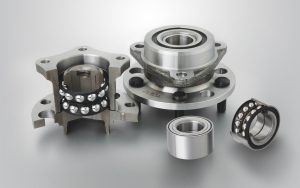As vehicles continue to evolve toward full connectivity, electrification, and autonomous operation, traditional mechanical components are being transformed into intelligent, data-driven systems. One of the most significant advancements in this shift is the development of smart wheel hubs and sensor-integrated wheel bearings.
Once simple elements that supported wheel rotation, wheel bearings are now becoming sophisticated monitoring devices capable of enhancing safety, performance, and predictive maintenance. This transformation is redefining how modern vehicles operate and interact with their environment — especially in connected and autonomous mobility.
What Makes a Wheel Bearing “Smart”?

A smart wheel bearing integrates electronic sensors directly into the bearing or hub assembly. These sensors collect real-time data that can be transmitted to the vehicle’s control units, allowing continuous monitoring and precise adjustments.
Key integrated technologies include:
-
Speed sensors (ABS/ESP)
-
Temperature sensors
-
Load and vibration sensors
-
Wireless communication modules
-
Diagnostic microchips
These technologies enable the bearing to not only rotate the wheel smoothly but also become a reliable source of critical information for vehicle safety and performance systems.
Why Smart Hubs and Bearings Matter in Modern Cars
Smart hubs and sensor-equipped bearings support many high-tech vehicle features. Their integration directly improves:
1. Safety
-
Provides accurate wheel-speed data for ABS/ESC.
-
Detects early bearing wear before failure.
-
Supports autonomous braking and steering corrections.
2. Predictive Maintenance
-
Real-time temperature and vibration monitoring.
-
Alerts drivers to bearing degradation.
-
Prevents catastrophic wheel separation.
3. Energy Efficiency
-
Optimizes rolling resistance.
-
Adjusts EV torque distribution based on wheel load.
-
Reduces unnecessary power consumption.
4. Autonomous Vehicle Functionality
-
Ensures precise wheel-speed data for AI navigation.
-
Supports advanced lane-keeping and adaptive cruise control.
-
Communicates directly with control units for millisecond-level adjustments.
Key Features of Next-Generation Smart Wheel Bearings
| Feature | Description | Benefit |
|---|---|---|
| Integrated Sensors | ABS, force, temperature, and vibration sensors | Real-time safety data |
| Self-Diagnostics | On-board microchips monitor bearing health | Predictive maintenance |
| Wireless Communication | Data transfer to vehicle ECU or cloud | Enables connected services |
| Enhanced Sealing | Protects electronics and bearing surfaces | Longer lifespan |
| Low-Friction Design | Optimized lubrication circuits | Improved efficiency |
These features make smart bearings an essential element in future-proof vehicle architectures.
How Smart Bearings Work in Connected Vehicles
Smart hubs continuously collect data as the wheel rotates. This data is processed through an embedded microcontroller and transmitted to the vehicle’s electronic systems.
Process overview:
-
Sensor Detection
-
Records speed, heat, vibration, and load.
-
-
Signal Processing
-
Internal chips filter and interpret raw values.
-
-
Data Transmission
-
Sends results to ABS, ESC, and vehicle ECU.
-
-
System Response
-
Adjusts braking, power distribution, and stability controls.
-
-
Diagnostic Logging
-
Stores anomalies for service technicians or cloud analytics.
-
This real-time, fully automated feedback loop is essential for connected and autonomous vehicle platforms.
Benefits for Electric and Hybrid Vehicles
EVs and hybrids place unique demands on wheel bearings due to heavier battery packs and instant torque. Smart hubs help counter these challenges by offering:
-
Load balancing for heavier vehicles
-
Advanced torque vectoring for EV motors
-
Reduced mechanical resistance for extended range
-
Thermal management for high-torque acceleration
In EV platforms, smart bearings are rapidly becoming standard.
Common Sensor Types in Smart Wheel Hubs
| Sensor Type | Function |
|---|---|
| ABS/Speed Sensor | Measures wheel rotation for braking and traction systems |
| Temperature Sensor | Prevents overheating and lubrication failure |
| Vibration Sensor | Detects worn races, pitting, or misalignment |
| Load Sensor | Helps adjust stability control and torque distribution |
These sensors make each wheel a live data point for the entire vehicle network.
Are Smart Wheel Bearings the Future Standard?
Absolutely. With global trends pushing for autonomous, electric, and connected mobility, traditional passive components are no longer sufficient.
Future vehicles will rely on real-time, sensor-driven intelligence, not only for performance but for safety and regulatory compliance.
Where to Buy Reliable Wheel Hubs and Bearings

If you’re upgrading or replacing wheel bearings, choose high-quality and OEM-compatible parts. You can Buy Wheel Hub & Bearings online from trusted suppliers at this link:
Buy Wheel Hub & Bearings online
Conclusion
Smart hubs and sensor-equipped wheel bearings mark a major step forward in modern vehicle engineering. They transform a once simple mechanical component into a multifunctional, data-rich device that enhances safety, performance, and reliability. As vehicles move toward full connectivity and autonomy, these intelligent bearings will become indispensable — helping drivers and automated systems react faster, operate more efficiently, and maintain better long-term vehicle health.
The future of transportation is connected, and smart wheel bearings are one of the key technologies driving this transition.